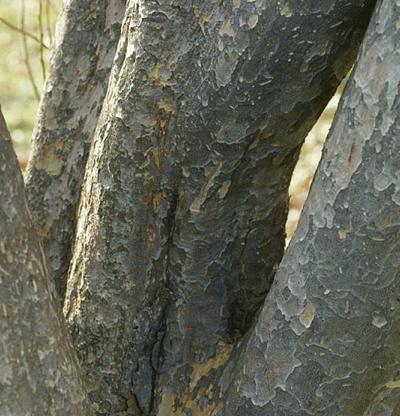





 Persian parrotia tree (Parrotia persica)
par-ROE-tee-ah PER-sih-kah
Genus:
Parrotia
Parrotia persica has one of the most beautiful foliage displays, in addition to year-round eye appeal and ease of maintenance. Reddish-purple when unfolding in spring, the leaves are a lustrous dark green in summer, and yellow to orange or scarlet in fall. Leaves hold their color for a long period. Older branches and trunks develop an exfoliating gray, green, white, and brown color that is a welcome asset in the winter garden. It grows successfully in Zones 4 to 8, tolerates sun and partial shade, and is easy to transplant. Often, vegetatively propogated forms offer more reliable fall color.
Noteworthy Characteristics:
Easy to grow. Nice foliage spring through fall, often with great color in the autumn. Bark exfoliates with age. Tiny red flowers in winter.
Care:
For best autumn color, grow in acidic soil. It also needs deep, fertile, moist soil in full sun or part shade. Prune minimally—simply remove crossing branches or those that are growing in an unattractive direction.
Propagation:
Sow seed in a cold frame in the autumn; take greenwood cuttings in early summer, or semi-ripe cuttings in mid- and late summer.
Problems:
Infrequent.
Persian parrotia tree (Parrotia persica)
par-ROE-tee-ah PER-sih-kah
Genus:
Parrotia
Parrotia persica has one of the most beautiful foliage displays, in addition to year-round eye appeal and ease of maintenance. Reddish-purple when unfolding in spring, the leaves are a lustrous dark green in summer, and yellow to orange or scarlet in fall. Leaves hold their color for a long period. Older branches and trunks develop an exfoliating gray, green, white, and brown color that is a welcome asset in the winter garden. It grows successfully in Zones 4 to 8, tolerates sun and partial shade, and is easy to transplant. Often, vegetatively propogated forms offer more reliable fall color.
Noteworthy Characteristics:
Easy to grow. Nice foliage spring through fall, often with great color in the autumn. Bark exfoliates with age. Tiny red flowers in winter.
Care:
For best autumn color, grow in acidic soil. It also needs deep, fertile, moist soil in full sun or part shade. Prune minimally—simply remove crossing branches or those that are growing in an unattractive direction.
Propagation:
Sow seed in a cold frame in the autumn; take greenwood cuttings in early summer, or semi-ripe cuttings in mid- and late summer.
Problems:
Infrequent.
Copyright © www.100flowers.win Botanic Garden All Rights Reserved